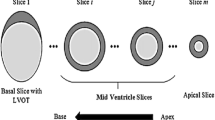Abstract
We propose a pipeline for the segmentation of the left cardiac ventricle (LV) in 4D CT data based on the random walker (RW) algorithm. A segmentation of the LV allows to extract clinical relevant parameters such as ejection fraction (EF) and volume over time (VoT), supporting diagnostic and therapy planning. The presented pipeline works aside approaches incorporating annotated databases, statistical shape modeling or atlas-based segmentation. We have tested our segmentation approach on six clinical 4D CT datasets including different pathologies and typical artifacts and compared the segmentation results to manually segmented slices. We achieve a minimum sensitivity of 86% and specificity of 96%. The resulting EF and VoT is comparable to known reference values and reflects the present pathologies correctly. Additionally, we tested three different routines for thresholding the RW probability maps. An interview with surgical and radiological experts together with high sensitivity scores indicates the superiority of the fixed threshold selection method – especially in the presence of pathologies. The segmentation is also correct near problematic fine structures such as cardiac valves, papillary muscles and the apex of the heart.
Access this chapter
Tax calculation will be finalised at checkout
Purchases are for personal use only
Preview
Unable to display preview. Download preview PDF.
Similar content being viewed by others
References
Jolly MP. Combining edge, region, and shape information to segment the left ventricle in cardiac MR images. Lect Notes Computer Sci. 2010; p. 482–90.
Zheng Y, Barbu A, Georgescu B, et al. Four-chamber heart modeling and automatic segmentation for 3-D cardiac CT volumes using marginal space learning and steerable features. IEEE Trans Med Imaging. 2008;27(11):1668–81.
Kirisli HA, Schaap M, Klein Sea. Fully automatic cardiac segmentation from 3D CTA data: a multi-atlas based approach. Proc SPIE. 2010;7623:762305–1.
Pfeifle M, Born S, Fischer J, et al. VolV - Eine OpenSource-Plattform für die Medizinische Visualisierung. Proc CURAC. 2007; p. 193–6.
Wellein D, Pfeifle M, Althuizes M, et al. A cortex segmentation pipeline. Proc BVM. 2010; p. 271–5.
Perona P, Malik J. Scale-space and edge detection using anisotropic diffusion. IEEE Trans Pattern Anal Mach Intell. 1990;12(7):629–39.
Grady L. Random walks for image segmentation. IEEE Trans Pattern Anal Mach Intell. 2006;28(11):1768–83.
Grady L, Jolly MP. Weights and topology: a study of the effects of graph construction on 3D image segmentation. Med Image Comput Comput Assist Interv. 2008; p. 153–61.
Author information
Authors and Affiliations
Corresponding author
Editor information
Editors and Affiliations
Rights and permissions
Copyright information
© 2011 Springer-Verlag Berlin Heidelberg
About this chapter
Cite this chapter
Dinse, J. et al. (2011). Extracting the Fine Structure of the Left Cardiac Ventricle in 4D CT Data. In: Handels, H., Ehrhardt, J., Deserno, T., Meinzer, HP., Tolxdorff, T. (eds) Bildverarbeitung für die Medizin 2011. Informatik aktuell. Springer, Berlin, Heidelberg. https://doi.org/10.1007/978-3-642-19335-4_55
Download citation
DOI: https://doi.org/10.1007/978-3-642-19335-4_55
Published:
Publisher Name: Springer, Berlin, Heidelberg
Print ISBN: 978-3-642-19334-7
Online ISBN: 978-3-642-19335-4
eBook Packages: Computer Science and Engineering (German Language)




